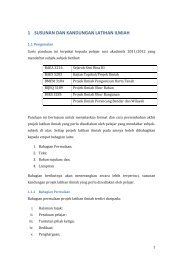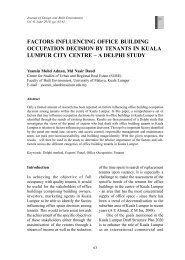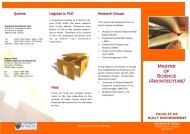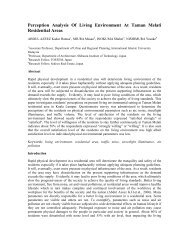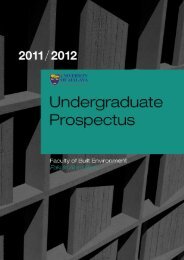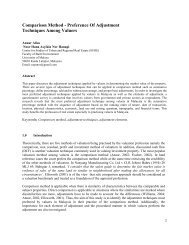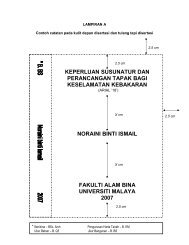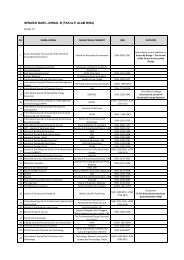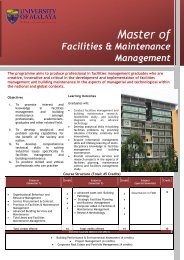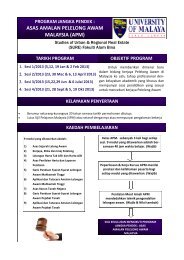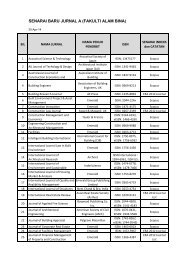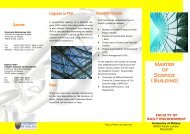Abstracts Vol.2 - Faculty of Built Environment
Abstracts Vol.2 - Faculty of Built Environment
Abstracts Vol.2 - Faculty of Built Environment
Create successful ePaper yourself
Turn your PDF publications into a flip-book with our unique Google optimized e-Paper software.
Abstract JDBE Vol. IIfile://D:\AZZYATY\Web\journal\abstract\abstractvol-II.htmPage 3 <strong>of</strong> 410/29/2009order to assess its positive and negative features (impact on the building). The results will provide abasic understanding <strong>of</strong> heat transfer and human thermal comfort requirements. It also providesfoundation for which an energy efficient design <strong>of</strong> buildings can be established.The design <strong>of</strong> residential buildings has a significant impact on everyday lives <strong>of</strong> people. It includesthe types and forms <strong>of</strong> buildings that are commonly occupied by people. In Malaysia, the ‘terracehouse’ constitutes the majority <strong>of</strong> the residential building stock on which this study is based. Thestudy considers the effects <strong>of</strong> the different ro<strong>of</strong> angles on reducing solar gain and indoortemperatures through eight directions within 24 hours.To analyse and explain that effect, five different angles <strong>of</strong> ro<strong>of</strong> were chosen for the simulations. Ingeneral, all the angles were chosen due to their architectural design characteristics. These angles startfrom 0 degree as a horizontal flat ro<strong>of</strong> to 60 degrees, i.e. increment <strong>of</strong> every 15 degrees. The researchis seen as providing a tool in evaluating the dynamic indoor air temperature and the effect <strong>of</strong> ro<strong>of</strong>angles. The evaluation is derived from a series <strong>of</strong> computer simulations using commerciallyavailable s<strong>of</strong>tware called BLAST.Keywords : ro<strong>of</strong> design, thermal comfort, orientation, indoor air.Urban Recreational Riverfronts: Successful Revitalisation ElementsHazreena HusseinDepartment <strong>of</strong> Architecture<strong>Faculty</strong> <strong>of</strong> <strong>Built</strong> <strong>Environment</strong>University <strong>of</strong> MalayaAbstractThis research identifies characteristics, which are the Theme, Identity, Functions and Authenticity <strong>of</strong>some current riverfront developments, mainly focusing in urban areas. The study began with theevolution <strong>of</strong> an urban riverfront, including understanding how early settlements were establishedalong the river, later forming the town, leading to the present day cities and their inherent traditionalurban culture value. Case studies selected were from South East Asia within Singapore and Sarawakin Malaysia. These examples will then be compared with London and Boston, USA. Much attentionwill be given to paying high respect to the cities’ character and to acknowledging the historical andcultural background <strong>of</strong> the city where they are set by scrutinising their characteristics. Theconclusion will be systematically analysed on design elements and careful considerations throughdesign planning and sensitive approaches.Keywords : Urban Riverfront Revitalisation, Theme, Identity, Functions, Authenticity



